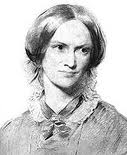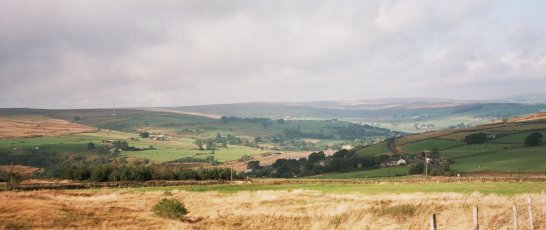Jane Eyre : a "coming-of-age" novel
par Me Esse

 Read about the Brontë sisters and the place where they lived : Haworth
Charlotte’s most famous novel depicts the emotional and spiritual development of the heroine, which is mirrored by her physical journeyings throughout the book. It describes her search for self-worth, for identity as an individual and for economic independence, in a world which did not expect such ambitions in women.
Read about the Brontë sisters and the place where they lived : Haworth
Charlotte’s most famous novel depicts the emotional and spiritual development of the heroine, which is mirrored by her physical journeyings throughout the book. It describes her search for self-worth, for identity as an individual and for economic independence, in a world which did not expect such ambitions in women.
Jane first appears as an orphaned child, lodged with an aunt who resents her and shamelessly favours her own children. She is sent away to a charity school run by Mr Brocklehurst, where, through the harsh regime, she learns survival and eventually succeeds in becoming a teacher there herself. She advertises for a post as governess, and is appointed to care for Adele, the ward of the sardonic Edward Rochester at Thornfield Hall. Thus far, Charlotte is drawing heavily on her own and her sisters’ lives, but it is not an autobiographical novel. The aunt who brought Charlotte up was a benevolent influence. By contrast, her experiences, and those of her sisters, as governesses were far bleaker than that portrayed here. And there was never any Rochester to fall in love with her.
What attracts Rochester to Jane is not her looks (she is small and plain, like her author) but the honesty with which she speaks her mind, and her practical common sense, which enables her to save his life. He proposes marriage, but she discovers at the altar that he already has a wife, Bertha, a lunatic who is kept in the attic at Thornfield. Jane refuses to become Rochester’s mistress, and flees from him. Destitute, she is taken in by the Rivers family, who, coincidentally, turn out to be cousins, and reveal that she is heiress to sufficient funds to give her financial security for life. The Revd. St. John Rivers, who is planning to go to India as a missionary, asks her to marry him and follow him in his calling. Jane is on the point of acceptance, when she hears a supernatural cry from Rochester. She returns to Thornfield to find that the house has been burned down by Bertha, and that Rochester himself has been maimed and blinded in an unsuccessful attempt to save his wife. Now, Jane can marry him, not just because he is widowed but because his physical dependence gives her the equality to which she aspires.
Elements of the uncanny, the fairy tale and the supernatural abound in Jane Eyre. Storms and fires reflect the psychological turmoil of the protagonists, while hauntings and transformations give a sense of dream or nightmare.
The world through which Jane moves has a strong moral dimension (unlike Wuthering Heights) which initially oppresses her, but which she confronts and finally comes to terms with. Brocklehurst and St. John Rivers are pillars of the church, but their stony formalism precludes real emotional warmth. Jane has to seek her own salvation, but she does so in traditional Christian terms ; by sacrificing her prospective life with Rochester, she ultimately saves it, herself and him.
Background : Before we begin to read Jane Eyre, we need to have a sense of the time period in which it takes place. The novel, set in the mid-1800s in England, focuses around the life of a girl who struggles with finding her place in the world. Jane suffers several traumatic events in her early life and must learn to cope on her own. The novel is classified as a Bildungsroman, or coming of age, because we see Jane grow up in the midst of the negativity surrounding her.
Task : The purpose of this assignment is to research topics which will give us a better understanding of the novel’s historical context. Use a separate sheet of paper to take notes on the topics below. Begin by using the links provided for each topic, but you can also use additional sources to supplement your research. Be sure to indicate which sources you use. Your notes should demonstrate that you have a basic understanding of each topic.
![]() Bildungsroman – (coming-of-age novel)
Bildungsroman – (coming-of-age novel)
Describe the genre. What characteristics should a piece of literature have to be classified as this ?
http://www.victorianweb.org/genre/hader1.html
![]() Education –
Education –
What was the mentality of private education in 19th century England ? What role did religion have in education ? What role did discipline have in education ? What are some reasons a family would send a child to private school ?
[https://victorianchildren.org/victo...]
http://www.primaryhomeworkhelp.co.uk/victorians/children/schools.htm
http://www.primaryhomeworkhelp.co.uk/victorians/children/schools.htm
![]() Role of Governess –
Role of Governess –
Define the term. What is the purpose of this profession ? What role did this person have in society ?
http://www.victorianweb.org/gender/wadso2.html
http://www.victorianweb.org/authors/gaskell/61n_s7.html
![]() Typhus & Tuberculosis –
Typhus & Tuberculosis –
Define both terms. What impact did each have on the world during this time period ? Who were mostly affected ?
http://www.vam.ac.uk/content/articles/h/health-and-medicine-in-the-19th-century
http://www.victorianweb.org/science/health/health10.html
![]() The author, Charlotte Brontë : read her biography here and here, and take notes.
The author, Charlotte Brontë : read her biography here and here, and take notes.
![]() the novel : read a summary of the plot here
the novel : read a summary of the plot here
![]() Jane Eyre : the role of women
Jane Eyre : the role of women
https://www.bbc.co.uk/history/trail/victorian_britain/women_home/ideals_womanhood_01.shtml
![]() Jane Eyre : The rebellious child
Jane Eyre : The rebellious child
I am glad you are no relation of mine : I will never call you aunt again as long as I live. I will never come to see you when I am grown up ; and if any one asks me how I liked you, and how you treated me, I will say the very thought of you makes me sick, and that you treated me with miserable cruelty. (ch. 4)
When Jane Eyre was published in 1847, it introduced a new voice to the world – a passionate, angry and defiant child. There were many passionate children in the moral instruction books designed for children in the early decades of the 19th century, but in these cases, they were examples of bad or sinful behaviour. Such children had to mend their ways, or suffer a terrible fate. In the case of Jane Eyre, however, Charlotte Brontë clearly expected her readers to be on the side of her defiant child as she stands up to adult tyranny.
![]() Jane Eyre : Fairytale and realism
Jane Eyre : Fairytale and realism
Jane Eyre is often seen as a profoundly realistic novel, drawing on Charlotte Brontë’s own experiences to paint a vivid picture of Jane’s suffering at Lowood and her struggle against the narrow role that 19th-century society allotted to women. Nevertheless, the novel also contains a strong element of fantasy. Right from the start – hidden in the window-seat, where she sits, ‘cross-legged, like a Turk’ – Jane escapes into a world of imagination, losing herself in the wild frozen landscapes of Bewick’s History of British Birds, and thinking of the fairytales and ballads told by Bessie, the nurse, on winter evenings. Fantasy is thus established as a counterpoint to Jane’s real-life privations, and as a rich source of imagery.
![]() Watch this episode of "Crash Course Literature" on Jane Eyre and Charlotte Brontë :
Watch this episode of "Crash Course Literature" on Jane Eyre and Charlotte Brontë :


